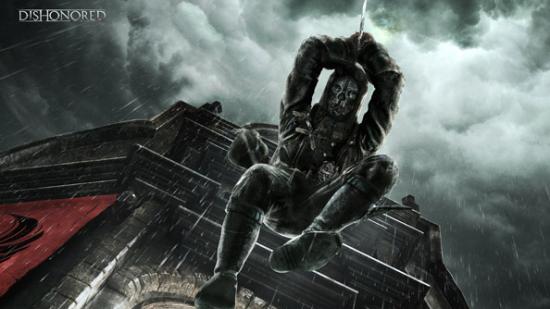“GAME OF THE YEAR!,” booms host Samuel L Jackson, before holding a long, wistful gaze with somebody in the 177th row. We’re at an alternate version of coarse US award-chute the VGAs that exists only in my head, and Dishonored is cleaning up.
“Game of the motherfucking year,” he sighs, swearily. He’s sitting now, cross-legged on a sticky, black stage. His anguished expression suggests he’d like the sticky blackness to open up and swallow him whole. “Sheee-it. But it won’t change a goddamn thing.”
I suppose I, like Sam, worry that Dishonored is doomed to be anomalous – a high watermark on an otherwise bone-dry scale, to be stared at sadly for another decade.
I’m concerned that the lead on Gears of War: Judgment feels the need to leave his own studio and start again to make games that reward player choice. I’m saddened to hear ex-Looking Glass designer Dorian Hart admit so readily that Austin’s finest didn’t change the industry, but merely birthed a beloved subgenre. And I’m distressed that Deus Ex alumnus Harvey Smith, a man who just gets it, has needed ten years simply to find the same page again.
But ‘Dishonored is my GOTY because it’s like Deus Ex’ is a distinctly lazy argument – the sound of an old man slipping comfortably back into his favourite subgenre. It certainly isn’t an acceptable explanation of Dishonored’s many charms, which range from the architectural to the cerebral. Most of the time though, Dishonored is about getting high. 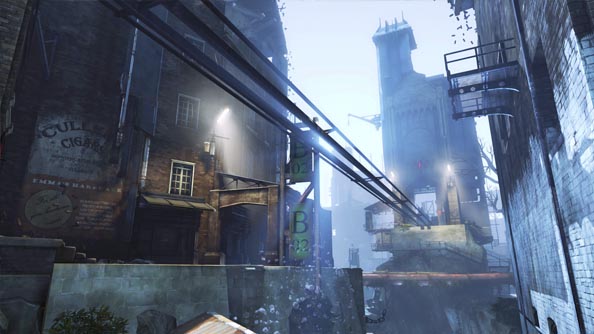
I’m talking verticality of course, silly – this isn’t Far Cry 3. Here’s the thing: FPS developers have had the Y-axis at their beck and call since the mid-’90s, but few remember to make use of it – and fewer still quite like this. Dishonored’s levels are packed, dense things, filled not only with streets, courtyards and atriums but also myriad unseen antechambers, apartments, basements and balconies – all at varying levels of altitude.
The result is tens of tangible temptations pulling at you in any given area – an open window up here; a trapdoor down there; somewhere in your peripheral vision, a broken grate just big enough to house a possessed rat. The masterstroke is Dishonored’s short-range teleport ability, Blink. “Ooo, that looks interesting! I’d like to go there,” says the player. “You already are,” replies Blink. “Where next?”
It gets no more complex and no less intuitive than that – the only issue is that blinking isn’t yet an industry standard. 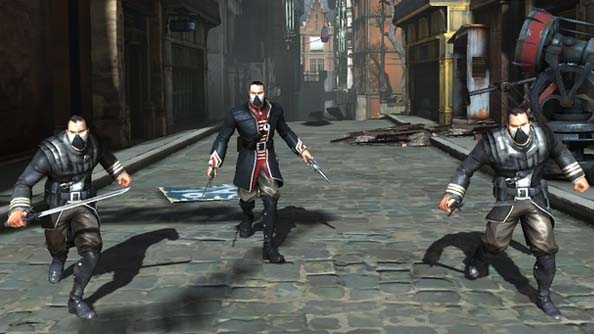
It helps, too, that Dishonored’s joy in movement is coupled with missions that are uniform triumphs of spatial sense, even when moving back and forth between area loading screens. The fact a mansion is the same size inside and out might not sound particularly important, but knowing exactly where a hapless guard will emerge next, for instance, can be instrumental in setting up a temporality-twisting explosive trap to snare him. And having a rough idea of where the nearest stairwell will lead won’t hurt the escape plan, either.
Whereas contemporary first-person games are renowned for making their boundaries invisible to the player, Dishonored makes you keenly aware of them, with the expressed purpose of letting you plan with precision.
What’s exciting about that explosive example, by the way, is that it wouldn’t have any place in my Dishonored. In my Dishonored, the masked man who visits a week’s worth of night terrors upon the city of Dunwall is merely a pacifist with a funny way of showing it. The fact that this can be either one of the year’s finest stealth games or an entirely different, equally compelling melee FPS is totally absurd. Wonderfully so. 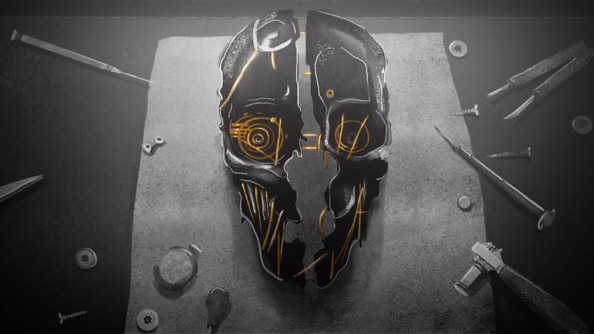
Then there’s Corvo, Dishonored’s protagonist. There’s something about the mask – the twisted metal contraption on the game’s cover – that didn’t strike me as especially interesting when I began the game, but which has since revealed itself over time. It’s the same mask that protagonist Corvo very conspicuously dons when knuckling down to the business of incapacitating strangers, and that he carefully removes before stepping off the boat back at his adopted home hub, the Hound Pits pub. A mask that makes clear that there’s a Corvo away, and a Corvo at home.
Most of PC gaming’s swiss army knife assassins couldn’t possibly function in a domestic setting. Remove the grunts they’re defined in opposition to and they’d simply cease to exist, vanishing with a bang as their limited logic short-circuits. Not Corvo. Though he begins the game tied limply to a tired revenge motif and a pantomime villain, Dishonored’s regular interludes at the Hound Pits sees his gradual unmasking.
Never have I been so aware of the effect my avatar has on the people around him as at the Hound Pits. Blink absentmindedly in the vicinity of Samuel the Boatman, for instance, and he’ll shout in disbelief. Reluctant revolutionary Admiral Havelock, too, is particularly inawed by Corvo’s abilities and writes incessantly about his new prize in his diary. It’s in the eyes of Empress’ daughter Emily, though – future throne-puppet and nine-year-old girl – that Corvo Attano’s real face is reflected. It’s she who leaves crude pencil portraits by your bed, humanising you even as you fall deeper into bloody conspiracy. 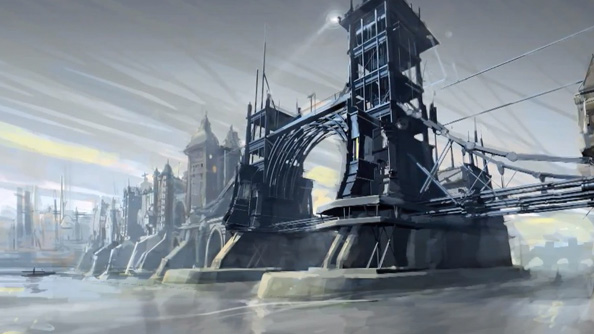
What else? Dunwall’s beautiful, of course. Like Viktor Antonov’s previous, City 17, it’s one city built on top of another, a visual lesson in the cultural whitewashing that comes with totalitarianism. It’s also the best London ever committed to code.
It’s funny to think about Dishonored’s exquisite Britishness in relation to the recently-announced criteria for UK development tax breaks. It seems French-Texan developers Arkane would more than qualify as a very British outfit, but I doubt Dunwall is entirely what our Tory government had in mind. Indeed, it hits uncomfortably close to home. Dishonored’s is a state, after all, where the rich hate and fear the poor, but a sweeping crisis touches all indiscriminately; where an aristocratic Parliament rules, despite near-universal discomfort about that fact; where even as things get better, Sam the Boatman worries aloud about the effects change will have on the working class. “We always get the worst of it,” he says.
I wouldn’t call Dishonored politicised, but it has the UK zeitgeist nailed above its fireplace like a whaleboat painting.
So I’m in love with this game that’s at once tight and sprawling, both economic and maximalist. And I’m training myself not to worry that we don’t see its like too often. It looks like we might be getting a sequel, but don’t expect to see any rivals. Instead, I’ll be relatively content to see next year’s games steal lead from its roof, repurposing loose bricks from its intimidatingly high walls.
Dishonored is a game to take from, to pull apart and study. Because we can’t let all of its victories slip away – not again. Not on alternate universe Samuel L Jackson’s watch.
